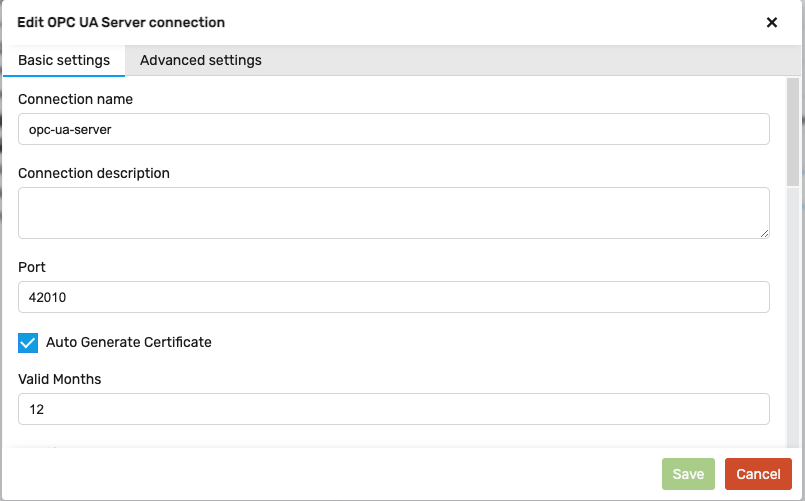OPC UA Server
logiccloud Control runtimes can act both as an OPC UA Client and Server. If you want to use logiccloud Control as OPC UA Server, add a new OPC UA Server connection.

Basic Connection settings:
Connection name: name of the connectionConnection description: description, optionalPort: Exposed portAutogenerate certificates: If enabled, certificates will be created automaticallyValid Months: Validity timeframe for certificatesKey size: Certificate key sizeCertificate path: Path, where certificate is storedKey path: Path, where certificate key is storedIssuer Certificates Path: the file path of the issuer certificates. Issuer certificates are needed for validation, but are not trusted. Path may be to a file, comma-separated list of files, or directory.Issuer CRLs Paths: the file path of the issuer revocation lists. Path may be to a file, comma-separated list of files, or directory.Trusted Certificates Paths: the file path of the trusted certificates. Path may be to a file, comma-separated list of files, or directory.Trusted CRLs Paths: the file path of the trusted revocation lists. Path may be to a file, comma-separated list of files, or directory.Rejected Certificates Path: the file path where rejected certificates are stored. Path must be to a directory.User: the username that might be used by a client for a secure connection.Password: the password that might be used by a client for a secure connection.
Advanced Connection Settings:
Allow anonymous users: If enabled, clients can connect without credentialsAllow Write anonymously: If enabled, anonymous clients can write variablesAllow policy none: Whether to allow security policy with no encryption; default: falseSkip client certificate check: If enabled, client certificates will not be checkedEnable diagnostics: Whether the server exposes its metrics; default: trueTrace requsts responses: Whether the server logs all low-level ServiceRequests and ServiceResponses to StdOut; default: falseMax session count: the number of sessions that may be active. default: 0 (no limit)Max Subscription count: the number of subscriptions that may be active. default: 0 (no limit)Max Worker Threads: the number of worker threads that may be created. default: 4Max Buffer Size: is the limit on the size of the send and receive buffers.Max Message Size: is the limit on the size of messages that may be accepted.Max Chunk Count: is the limit on the number of message chunks that may be accepted.Max String length: the maximum number of bytes in Strings supported by Variables of the Server.Max Array Length: the maximum length of a one or multidimensional array supported by Variables of the Server. In a multidimensional array it indicates the overall length.Max Byte string length: he maximum number of bytes in a ByteString supported by Variables of the Server. It also specifies the default maximum size of a FileType Object’s read and write buffers.Max browse continuation points: is an integer specifying the maximum number of parallel continuation points of the Browse Service that the Server can support per session. The value specifies the maximum the Server can support under normal circumstances, so there is no guarantee the Server can always support the maximum. The client should not open more Browse calls with open continuation points than exposed in this Variable. The value 0 indicates that the Server does not restrict the number of parallel continuation points the client should use.Max query continuation points: is an integer specifying the maximum number of parallel continuation points of the QueryFirst Services that the Server can support per session. The value specifies the maximum the Server can support under normal circumstances, so there is no guarantee the Server can always support the maximum. The client should not open more QueryFirst calls with open continuation points than exposed in this Variable. The value 0 indicates that the Server does not restrict the number of parallel continuation points the client should use.Min supported sample rate: the minimum supported sample rate, including 0, which is supported by the Server.Max nodes per read: the maximum size of the nodesToRead array when a Client calls the Read Service.Max nodes per write: the maximum size of the nodesToWrite array when a Client calls the Write Service.Max nodes per browse: the maximum size of the nodesToBrowse array when calling the Browse Service or the continuationPoints array when a Client calls the BrowseNext Service.Max nodes per register nodes: the maximum size of the nodesToRegister array when a Client calls the RegisterNodes Service and the maximum size of the nodesToUnregister when calling the UnregisterNodes Service.Max nodes per translate browse path to node ids: the maximum size of the browsePaths array when a Client calls the TranslateBrowsePathsToNodeIds Service.Max nodes per node management: the maximum size of the nodesToAdd array when a Client calls the AddNodes Service, the maximum size of the referencesToAdd array when a Client calls the AddReferences Service, the maximum size of the nodesToDelete array when a Client calls the DeleteNodes Service, and the maximum size of the referencesToDelete array when a Client calls the DeleteReferences Service.Max monitored items node call: the maximum size of the itemsToCreate array when a Client calls the CreateMonitoredItems Service, the maximum size of the itemsToModify array when a Client calls the ModifyMonitoredItems Service, the maximum size of the monitoredItemIds array when a Client calls the SetMonitoringMode Service or the DeleteMonitoredItems Service, the maximum size of the sum of the linksToAdd and linksToRemove arrays when a Client calls the SetTriggering Service.
After adding the connection, you can also add OPC UA Server Profiles and OPC UA Server local ids:

Mapping process variables
You can then map individual process variables to OPC UA Nodes. For this, go to the mappings, select Variables, add Node Address, Data Type, and Access Level.
